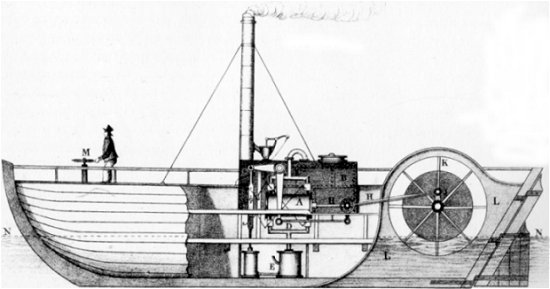The Charlotte Dundas
Today, another first steamboat. The University of Houston's College of Engineering presents this series about the machines that make our civilization run, and the people whose ingenuity created them.
France, the United States, and Scotland each has its own first steamboat. In France, the marquis de Jouffroy built the earliest one, and demonstrated it on the Saonne River, in 1783. John Fitch actually operated a steamboat passenger service between Philadelphia and Trenton during the summer of 1790.
The first British steamboat has had less attention here, in the United States. While Fitch was working on his steamboat in America, a retired banker named Miller was working with an employee on steam-powered pleasure boat for his Edinburgh estate.
When they read about yet another American who'd received a steamboat patent, Miller hired Scottish engineer William Symington. Symington had already built the first plausible steam-powered automobile. Now he finished a real steamboat for Miller, by 1788. He made a second, larger, boat a year later. Unloaded, it traveled seven miles per hour.
But miller was very critical of the clumsy rack-and-pinion drive system that Symington had cooked up for his boat, and he lost interest. He went on to other things. Twelve years later, Lord Dundas, Governor of the Forth and Clyde Canal Company, asked Sym-ington if he could build a functional commercial steamboat.
This time, Symington developed a slider-crank drive system and, in 1802, he unveiled a fine steam-powered tugboat. He named it Charlotte Dundas. On its maiden voyage, the Charlotte Dundas carried Lord Dundas and an archbishop. The twenty-mile trip took six hours; but the Charlotte Dundas was now hauling two seventy-ton barges, and it was doing so against strong head winds.
So Lord Dundas ordered eight more steamboats to be built. Then conservative forces rose up against a new (and hence fearful) technology. Opponents argued that the paddle wheel action would erode the canal banks. The enterprise finally collapsed.
That same year, we find two Americans in Paris: On a business trip there, wealthy promoter Robert Livingston met Robert Fulton. Fulton was trying to sell the French Navy a submarine he'd designed. Livingston told Fulton that he would invest big money in the creation of a practical steamboat. So Fulton dropped submarines.
Historian James Flexner says that Fulton was "less interested in originality than results." Fulton knew the history of previous steamboats very well, and he made no priority claims to the basic idea. First, he tried to build a steamboat for Napoleon. It failed because the engine was too heavy for the structure. Five years later, he got it right on the Hudson River, in New York.
But Flexner points to Symington's Charlotte Dundas as the one steamboat invention that did not, in some way, eventually feed Fulton. It was a fine machine. And, but for public fears, it could easily have been the beginning of steamboat service in Great Britain -- five years before Fulton's boats began spreading across America.
I'm John Lienhard, at the University of Houston, where we're interested in the way inventive minds work.
(Theme music)
J. T. Flexner, Steamboats Come True. Boston, Little, Brown and Company, 1978 [1944].
H. Dale, and R. Dale, The Industrial Revolution. New York: Oxford University Press, pp. 32-34.

The Charlotte Dundas
(Image from Bowie, 1883)